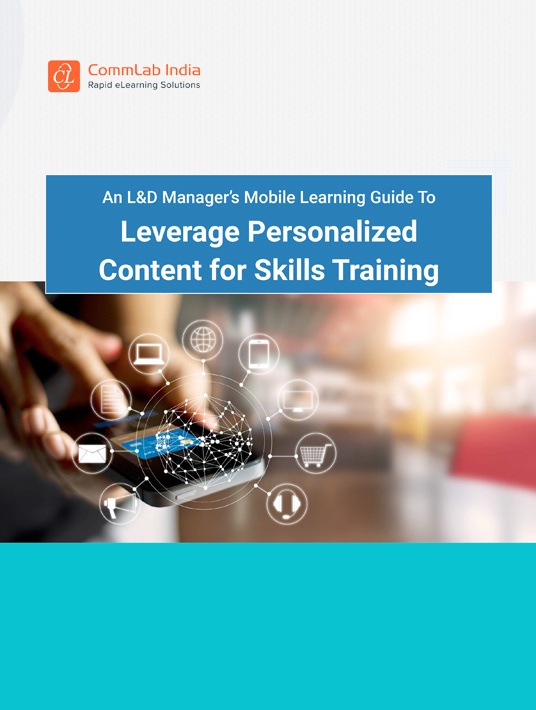5-Step Solution For Implementing Personalized Learning Paths With Mobile Learning
Most training is planned with a ‘one-size-fits-all’ strategy. Learners undergo training according to a pre-defined schedule – usually at a fixed physical location. Learning is linear, sometimes forcing learners to wade through large chunks of information. Content isn’t created or tailored according to individual preferences, learning styles, or work environments. How would you like it if you’re at the receiving end of such workplace training? Let’s look at how you can create effective personalized learning paths and where mobile learning can help.

Mobile Learning’s Role In Creating Personalized Learning Paths
1. Assess Individual Learner’s Needs Before Training Begins
To create personalized learning paths, it's crucial for your training goals to align with learners’ needs. Seamlessly blending course content and structure with learner needs is key to creating effective personalized learning – one that is meaningful and impactful for the learner.
For this, you need to assess individual learning needs before the training even begins to identify the ‘problems’ or ‘learning gaps’ the training is required to fill. Some learners may already have some knowledge of what is going to be taught, while for others, it may be all new. Either way, it’s imperative that you determine learners’ knowledge levels and their familiarity with the content to develop short-term, intermediate, and long-term personal learning goals.
So, how can you assess each learner’s individual learning needs?
The mobile learning solution
Use pre-training assessments on the mobile to determine:
- What each learner already knows
- Topics where they achieved success
- Topics that need additional training
Conducting pre-training assessments on mobiles means learners do not have to be physically present for the test. You can use an LMS to push an online assessment to their mobile devices and compile scores within minutes.
The LMS is equipped to generate reports based on the scores, giving meaningful insights into learners’ individual needs. You can even build a ‘skill matrix’ using these reports to determine how you could address the learning gaps and increase performance.
2. Select the Learning Model Based on the Pre-Training Assessments
Once data from the pre-training assessments is available, it is time to devise activities and resources that can be used to solve the ‘problem’ mentioned earlier.
- Link related learning modules to form one path
- Assign standalone modules as required
- Create as many learning paths as is required to suit different learners
No matter what kind of learning model you choose, remember to offer them in different formats.
A one-size-fits-all solution assumes all learners are the same – which is really not the case. Learning curriculums should be designed to suit the unique needs of each learner for them to receive the best possible workplace training.
The mobile learning solution
The flexibility of learning on-the-go, in different formats (audio, video, games, interactive text… you name it!) is one of the reasons why most companies are including mobile learning in their overall training strategy.
Take advantage of the mobile devices your learners carry and tailor content for them. Here are some examples of what you can do:
Convert long eLearning courses into a curriculum of short mobile learning modules (each around 5-10 minutes long). The lesser the cognitive load, the better the learning.
Offer content in the form of a (mobile) learning game, using gamification to drive engagement, increase participation, and foster competition among learners.
Use videos to make long and boring content interesting by leveraging personalized learning paths with mobile learning.
- Deliver procedural training in the form of demo videos with a combination of real footage, graphics, and animations.
- Develop short simulation videos for software training.
- Incorporate scenarios in mLearning videos to facilitate problem-based training, with learners having a chance to participate in real-life situations and learn to solve real world problems.
- Use infographics, checklists, and PDFs to summarize the training for a quick recap.
3. Identify Progress Markers to Ensure Accomplishment of Learning Goals
After training, use assessments to evaluate learning – whether learners were able to fill their learning gaps. Assessments may be:
- Formative assessment (after each topic or unit throughout learning; to reinforce learning)
- Summative assessments (at the end of the training to measure what has been learned, “assessment of learning”)
However, it’s important to offer the assessments online, because online assessments hosted on the LMS will allow tracking of learners’ progress.
The mobile learning solution
Mobile learning assessments are a big hit among modern learners. That’s because they can be taken anywhere, and any time (at work, while commuting, during breaks). What’s great about mLearning assessments is that they can be offered in any format you prefer. You can incorporate videos, games, and scenarios in assessments to help increase learner engagement. Group/collaborative mobile assessments give learners the opportunity to learn with their peers and share feedback and ideas remotely.
4. Continuously Monitor Performance; Use the LMS to Provide Adaptive Learning Paths
The recommendation is to continuously monitor learners’ learning activity throughout their learning journey (not just the assessments) with the help of your LMS. This not only helps you understand how learners are progressing through the already-customized learning, but also to create other learning paths based on how they are performing.
One of the most important aspects of the LMS is its capability to adapt to the learner’s profile. A new-age LMS usually contains all the available learning paths mapped to the characteristics of the learners. Optimal adaptive learning path algorithms within the LMS use this information to dynamically provide suitable courses and paths for each learner.
The mobile learning solution
If you have a mobile learning strategy in place, you can divide the entire training into a curriculum and have the LMS configured to offer suitable mLearning content based on the learner’s performance.
In case of eLearning also, when the learner has difficulty understanding a particular topic, the LMS can offer mobile-friendly material on that topic which they can go through outside the formal training environment. This could be in the form of mLearning videos, eBooks, infographics, or even micro modules that learners can access on-the-go and use as job aids.
Also, check learner retention by pushing assessments to their devices periodically. Periodic assessments provide up-to-date information about what each learner knows (‘remembers,’ to be more precise) so that you can identify areas for re-training and/or intervention.
5. Offer Learner-Specific Post-Training Performance Support
Performance support is all about helping learners with needed resources at the point of need. You must also send updated material to the learners as and when it is available. As with the primary training, post-training ought to be personalized too.
When learners encounter problems at work, finding the solution should not be a ‘needle-in-a-haystack’ activity. In other words, you mustn’t offer content-heavy resources that learners are forced to wade through to get to the require content. They need access to the right information at the click of a button (or a couple of buttons).
The mobile learning solution
Performance support and mobile learning usually go hand in hand. The mobile’s ubiquity among modern learners makes it the perfect device for offering on-the-job support. Also, the offline capabilities of a mobile device make it ideal for learners working in remote locations to access the content regardless of their Internet connectivity.
You can use a variety of mobile learning formats to support your learners in their work. Here are some examples:
- Short demo videos to show how to assemble a sophisticated piece of equipment
- Infographics to compress large pieces of information into charts and graphs
- Interactive how-to guides in the form of eBooks which pack interactivity
- Video, process maps
- Dedicated mobile apps to host learning resources and facilitate social/collaborative learning by allowing learners to – book a consultation with the SMEs/trainers for clarifications; interact with their peers on message forums and chat rooms; share learning with co-workers
- FAQs to help learners when the organization is initiating a change, such as a new CRM or software launch
Conclusion
Whether you decide to pepper your mobile learning with lots of videos and learning games or not, the mobile as the medium in itself is enough to motivate modern learners to take up training to improve their skills and performance.
Download the eBook An L&D Manager’s Mobile Learning Guide To Leverage Personalized Content For Skills Training to discover why team leaders need to take part in the mLearning revolution. You can also join the webinar to learn more about the impact of mobile learning on your performance management program.
References
- Pre-Assessments in eLearning: A Tool to Gain Employees’ Acceptance
- Making eLearning More Engaging with Software Simulations
- Collaborative Learning – Here’s Everything You Need to Know!
- Design Principles for Adaptive Learning: The 5 Cs You Can’t Skip
- It’s Time for a Rapid New-age Learning Management System (LMS)









